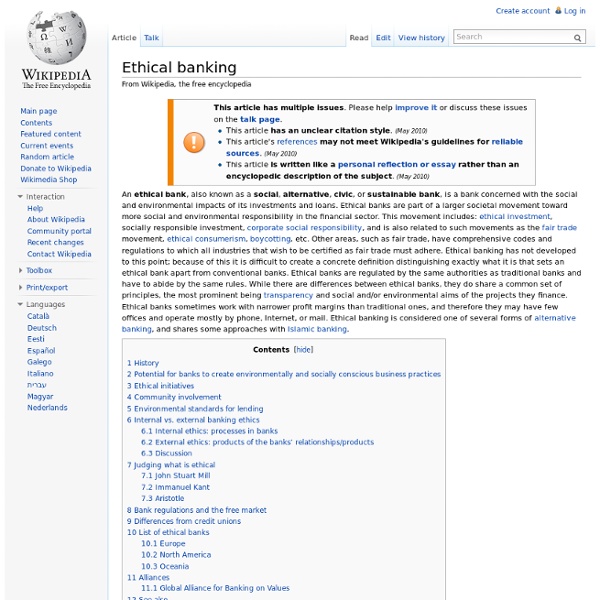EIRIS | Home
Alternative Banking
So, do you need a bank to bank? Do you have to get a loan from a bank or credit union? Do you need to have branch access in order to have a good banking experience? Can you get the best rates without a branch? The Branchless Bank Internet banking is not just online banking, it’s becoming a new service model. Peer to Peer Lending Some people have figured out that with the right tools, they can lend out money and make some interest on it. Money Management Tools Tools like Quicken and Money have been around forever, but new players have entered the market.
FTSE KLD 400 Social Index
This FTSE KLD 400 Social Index was launched in 1990 and is designed to help socially conscious investors weigh social and environmental factors in their investment choices. The eligible universe for the KLD400 is the 3,000 largest U.S. companies (by float-adjusted market capitalization) in the U.S. equity market. KLD selects the eligible universe index on April 15 (or closest business day) of each year. KLD defines U.S. equity as follows: U.S. headquarters Primary market listing is the NYSE or NASDAQ Companies with non-U.S. incorporation for tax or regulatory purposes are evaluated on a case-by-case basis. KLD follows the rules of the FTSE AWD USA Index. The following types of equities are not eligible for the KLD400:
Public Banking Institute - Banking in the Public Interest
Kylo Browser
Basic Banking System
Author: Bart klein Ikink Background Local currencies have proliferated in recent years and a number of transaction systems support those currencies [+]. Linkages between various types of local currencies and co-operative finance organisations are developing. In the United States, Alternatives Credit Union and Ithaca Money have formed a joint board. In southern Germany the Chiemgauer, which is a currency with a holding tax, is being supported by local social and co-operative banks. One of the most used systems is Cyclos. Most existing transactional systems are not able to support a replacement of the current usury financial system by local currencies with a holding tax. Cyclos has been around for many years and it is installed on a large number of locations. System scope The Basic Banking System is a simple system in the functional as well in the technical sense. Small banks should not have to consider organisational design and systems design. Additional information Introduction Roles
2.5D
2.5D ("two-and-a-half-dimensional"), ¾ perspective and pseudo-3D are terms, mainly in the video game industry, used to describe either 2D graphical projections and similar techniques used to cause a series of images (or scenes) to simulate the appearance of being three-dimensional (3D) when in fact they are not, or gameplay in an otherwise three-dimensional video game that is restricted to a two-dimensional plane. Common in video games, these projections have also been useful in geographic visualization (GVIS) to help understand visual-cognitive spatial representations or 3D visualization.[1] The terms ¾ perspective and ¾ view trace their origins to portraiture and facial recognition, where they are used to describe a view of a person's face which is partway between a frontal view and a side view.[2] Computer graphics[edit] Axonometric & oblique projection[edit] Lincity tiles 2D axonometric graphical elements to create a 2.5D game environment. Anatomy of an axonometric sprite. Mode 7[edit]
What’s the definition of a Transition Bank? | REconomy
A post by Shane Hughes. Our banks engage in industrial scale fraud and are more destructive than most of us realise, underming the transiton to a vibrant and resilient world. Given that mainstream banking reform fiddles around the edges, should (or could) our community groups proactively create the banks and banking system we want? Here’s my thinking… With vigor, our entrepreneurs set up energy companies, food coops, bakeries, pubs and repair shops. In this post i try to define a Transition Bank, I’ve covered the negative impacts of the existing banking system at the end of this post but I wanted to cut to the chase and summarise a proposed Transition Bank, with the following equation; Lets look at the equation in more detail. A credit union or similar coop, non profit-type structure - The typical CU structure fits well with many of the criteria for a Transition Enterprise and the Transition Principles especially in the community and profit related areas. Written by Shane Hughes.
Investors - GTSO Resources
New joint venture partner GTSO finalizes joint venture agreement with Chilerecicla, a top recycling company in Latin America, to expand its current operations in Chile to surrounding countries in Latin America. This new joint venture Chilerecicla E-Waste is a major step for GTSO Resources to expand its operations globally in an explosive region such as South America. Chilerecicla provides comprehensive management service and consultancy for the recycling of e-waste all over Chile and is rapidly expanding into other countries across Latin America. The corporate philosophy is to develop and promote sustainable business practices in companies producing or selling electronic equipment as well as proper disposal of e-waste for reuse. US and Global regulations supports urban mining future In 2010 only 27% of e-waste was recycled within the US and some 20 to 50 million metric tonnes of e-waste are generated worldwide every year. Learn more about traditional and urban mining now.



